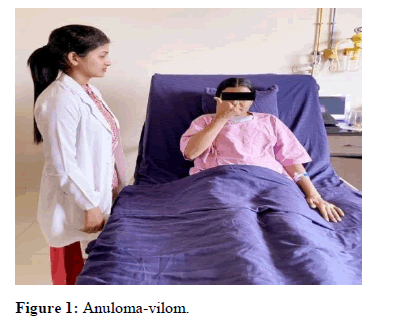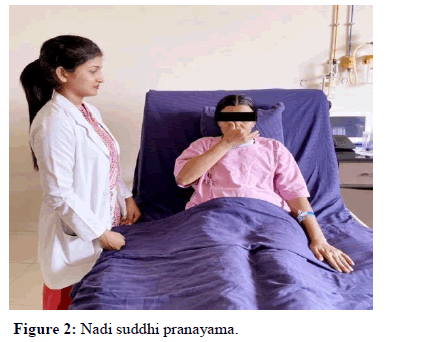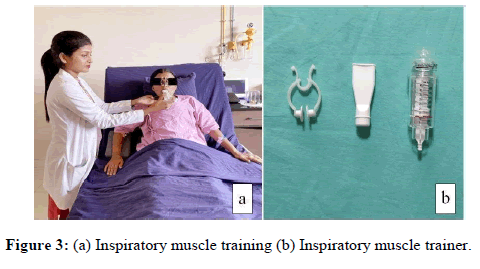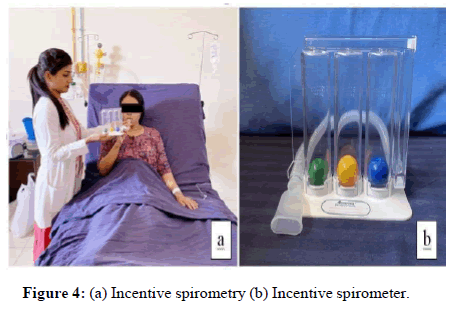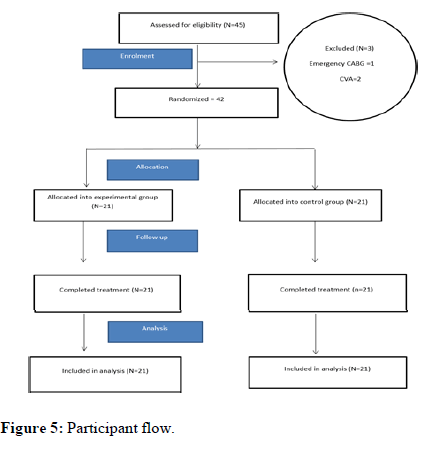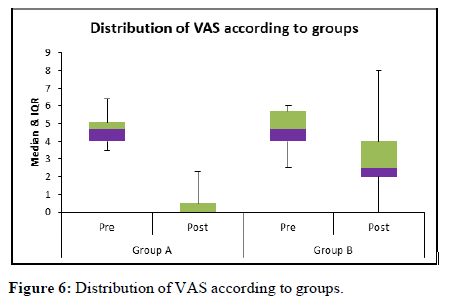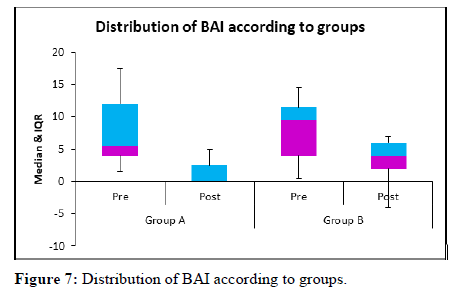Added Effect of Pranayama and Respiratory Muscle Training for Pain, Anxiety and Strength in Patients Undergoing Coronary Artery Bypass Graft Surgery: A Randomized Controlled Trial
Received: 02-Apr-2021 / Accepted Date: 16-Apr-2021 / Published Date: 23-Apr-2021 DOI: 10.4172/jcpr.1000141
Abstract
Background: Coronary Artery Disease (CAD) is common in adults. CABG is the most common surgical management for CAD in India. Pain and anxiety are commonly experience by patients undergoing cardiac surgery. These symptoms would result in prolonged recovery after surgery. Cardiac rehabilitation helps in faster recovery. Yoga is recognized as a most beneficial complementary and alternative therapy.
Objective: Effect of pranayama on pain and anxiety and respiratory muscle training in patient’s undergoing CABG.
Methods: All patients were screened based on inclusion and exclusion criteria prior to their assessment. Total of 42 subjects was randomized into group A (experimental, n=21), group B (Control, n=21). Experimental group was given pranayama and inspiratory muscle training on preoperative days and was continued from POD 4 TO POD 7 along with cardiac rehabilitation protocol. Group B followed cardiac rehabilitation protocol. Visual analog scale and Beck anxiety inventory score was assessed before the intervention and on POD 7.
Results: Experimental group showed effectiveness in VAS and BAI comparing to control group postoperatively.
Conclusion: From the study conducted we come to the conclusion that the outcomes measures pain, anxiety and strength differed during pre and post interventions in both the groups. Hence the selected interventions for the experimental group are effective in improving pain and anxiety.
Trial registration: Registration number of CTRI/2019/09/021281
Keywords: Relaxation technique; Muscle strengthening; Coronary artery diseases
Introduction
Background
Coronary Artery Diseases (also known as CAD) are most popular between adults. The pathology behind this condition is deposits of cholesterol in the coronary artery wall (artery which supply blood to heart) that results in heart attack or chest pain (Angina pectoris) and sometimes there won’t be any symptoms [1]. CAD is one of the most common forms of heart diseases. This is caused by buildup of the cholesterol in the inner layers of the arteries. As a result of which there will be reduced blood flow and the cardiac muscles do not get enough blood supply especially during exercise and exertion when demand is high [2]. There are various treatments for CAD, including dietary and behavioral change, lipid mitigating agents, blood pressure monitoring, and glycemic and antiplatelet management agents during early stages of CAD management. Coronary artery disease is one of the major contributors of global diseases and death. The early intervention steps are not enough to ensure a reasonable quality of life as the disease progresses. CABG is one of India's most popular surgical methods for treating CAD. CABG is a surgical technique involving bypassing the deposits of plaques by using another blood vessel in the body. The most preferred conduits are the internal mammary artery, saphenous venous graft, radial artery, etc. The incision is made at the midline of the sternum known as the median sternotomy. The surgical procedure can be done in two ways, while heart is continually beating (off pump CABG) or by stopping the heart and connecting into heart lung machine (on pump CABG) [3].
Advancements in coronary surgery (e.g., off-pump, CABG, smaller incision, improved myocardial security, use of arterial ducts and enhanced post-operative care) have diminished levels of morbidity, mortality and occlusion of the graft [4]. Over the past decade, preoperative cares in Coronary Artery Bypass Graft (CABG) surgery have advanced dramatically. This has resulted in low complication rate [5]. Pulmonary complications following surgery are a leading cause of postoperative morbidity and mortality. A typical preoperative intervention will be carried out in various disciplines, including intervention aimed at physiologically boosting cardiovascular respiration and musculoskeletal systems to mitigate the impact of general anesthesia (e.g., inspiratory muscle training, deep breathing exercise, preparation, early mobilization or awareness aimed at pre- operative and post-operative enhancement of these behaviors [6]. Pain and anxiety are generally felt by preoperative patients of cardiac surgery. Stress, rage, aggression, anxiety and depression have been well known influences in the temperament of patients suffering from coronary artery disease. Of this kind signs could lead to delayed restoration after surgery [7]. Postoperative complications such as pain, anxiety and depression are persistent problem following cardiac surgeries that are associated to restoration of patients.
Yoga is acknowledged as an addendum and holistic therapy of greatest value. Yoga is currently being pursued in western nations because of its popularity among the broader community. Yoga encompasses physical and mental health for positive health implications; it encompasses multiple Asanas (Yogic Activity) and Pranayama (Yogic Breathing Exercises) and Dhyana (Breathing techniques). Scientific studies have already identified yoga (pranayama and asana) routine that promotes prevention of atrial fibrillation, anxiety, depression and quality of life Pranayama improves cardiorespiratory system, lung functions, blood sugar, heart rate, lipid profile, Left Ventricular Ejection Fraction (LVEF), and mental health conditions [8]. Pranayama basically means control of prana. In Indian philosophy prana refers to all types of universe energy. Practice of pranayama induces a reduction in sympathetic basal tone [9]. In Sanskrit anulom means "Alternate." It is also known as Alternate Nostril Breathing. It can be practiced in any asana such as Vajrasana, Sukhasana, Padmasana, ideally holding the spine upright, mind relaxed. Alternate nostrils are blocked with thumb, ring finger and small finger of the right hand. The thumb will be used to seal the right nose and thus the ring & small fingers will be used to seal the left nose. Using thumb, right nostril is closed, exhalation through the left nostril accompanied by inhalation through the same. The ring finger then seals the left nostril, and air is exhaled through the right nostril followed by inhalation through the same [10].
Pranayama practice has been known to modulate autonomic cardiac status with an increase in cardio-respiratory functions. Nadi- Pranayama's cardiopulmonary responses are quickly altered and basic problem solving improves [11]. Inspiratory Muscle Training (IMT) is described as the technique of major advantage for helping the patients with impaired inspiratory muscle output, problem of dyspnea, reduced activity threshold and reduced functional capacity [12-17]. Yoga might play a pivotal role in the preventive measures of cardiovascular disease. Yoga-based rehabilitation plans boosts health, mental wellbeing, and quality of life following coronary artery bypass graft surgery. A newly developed yoga initiative post-surgical procedure dramatically reduces stress, anxiety and pain [18].
Objectives
To find the effect of pranayama and respiratory muscle training to reduce pain and anxiety in patients undergoing CABG surgery along with the routine cardiac rehabilitation protocol.
• The primary objective is to investigate the effect of pranayama and respiratory muscle training on pain in patients undergoing CABG.
• The secondary objective is to investigate the effect of pranayama and respiratory muscle training on anxiety in patients undergoing CABG.
Materials and Methods
Study design
This randomized controlled trial was conducted during the period between February 2019 to February 2020 in the Department of CTVS, Justice KS Hegde hospital, Deralakatte Mangalore, Karnataka state of India. The ethical approval was attained from the Institutional Ethics Committee of Nitte Institute of Physiotherapy, and trial was registered in CTRI. Written permission to conduct this study was obtained from the HOD of Cardiovascular and thoracic surgery department. The purpose of the study and a written informed consent was obtained from the subjects who were ready to participate in the study. All the patients were screened using the criterion for inclusion and exclusion prior to study, and randomized and allocated into either group based on computer- generated randomization and sequential numbered opaque sealed envelope method.
Participants
Eligibility criteria for participants were patients undergoing CABG surgery, within the age group of 30-70 years. Both male and females undergoing the surgery were screened and randomized accordingly. Exclusion criteria were emergency CABG, history of CVA, presence of neuromuscular disorder and aneurysm. 42 patients were randomized into two groups experimental and control group. Assessment was obtained prior to intervention (including type, intensity and duration of pain, VAS, BAI scale). Prior to intervention (pre-operative days) outcome scores were taken and on post-operative day 7 again scores were noted.
Intervention
Patients in experimental group received pranayama and inspiratory muscle training in addition to standard cardiac rehabilitation program pre-operatively and post-operatively from POD-4 to POD-7. The pranayama given was Anuloma-vilom and Nadi suddhi pranayama.
Pranayama breathing exercise
Anuloma-vilom and nadi suddhi pranayama: A session of pranayama lasts for 10 minutes each, which was performed twice a day (Morning & Evening). Pranayama exercise was performed in empty stomach.These were given two days before and after surgery, POD-4 to POD-7.
• Patient blocks the left nostril with a small finger, inhales and exhales only through the right nostril in Figure 1.
• Left nostril remains shut all time during exercise, single inhalation and exhalation phase forms one round.
• Perform nine rounds of practice.
• Close the right nostril with thumb tip.
• Only slowly inhale and exhale from the left nostril.
• Keep the right nostril closed during practice all the way.
• Practice nine rounds [19].
Note: The expiration period will be longer than that of the inhalation period.
Nadi suddhi pranayama
• Seal the right nostril with the right thumb and breathe out completely out of the left nostril. Then breathe in deeply through the same left nostril.
• Bind the ring finger and small finger to the left nostril, open the right nostril. Now slowly and totally exhale from the right nostril in Figure 2
• Using the same (right) nostril to inhale deeply. Then the right nostril is closed and the left nostril is exhaled. This forms a round
• Repeat nine rounds [19].
• Inspiratory muscle training was given to prevent any post-operative pulmonary complications.
• IMT; education in active cycle of breathing techniques, forced expiration techniques, incentive spirometry.
• Patient must be seated or in standing position, ensure no cloth is restricting the thorax.
• The patient was advised to' breathe in hard Push, push, pull and maintain the effort for at least 2 seconds and no more than 3 seconds, and keep encouraging throughout. Then the patient is advised to' relax and come off the mouthpiece in Figure 3
• The maximum load that can be sustained for 30 breathes.
• Repetitions: 30 breathe, with short breaks.
• Frequency: twice a day (morning and evening and not less than 6hrs apart)
• If there is residual fatigue, treatment won’t be given that day.
Active cycle of breathing techniques
• Patient should sit comfortably in such a position as:
• Lying on back with knees bent, lying horizontally or sitting up in a seated position.
• Hands should be placed over the stomach.
• Respire in deeply via the nose.
• Start to feel the air in your lungs and feel the stomach pressing into your palm.
• Slowly blow air via the pursed lips in one long, deep breath.
• Concentrate on letting the stomach sink in during breathing.
• Repeat the following steps to complete five respiration phases.
• Take another deep breath – hold for three seconds then huff out three times.
• On the third huff, cough deeply from the lungs, not the throat.
The control group received standard cardiac rehabilitation program and they were given deep breathing maneuver, incentive spirometry and coughing techniques. Outcome measure used was VAS and BAI scale. This was taken pre-operatively before intervention was began and post-operatively on POD-7.
Deep breathing maneuver: The patient should be in comfortable position, lie on back in bed, or with a pillow under the head and knees.
Instructions
• Breathe in via your nose. Fill up belly with full air.
• Exhale out through your nose.
• Place one hand over the stomach.
• Over the chest place your other hand.
• Feel your belly expand as you breathe in. Feel your belly lowering as you breathe out.
• The hand on your abdomen must move more than the one on your chest.
• Take another three breaths absolute and intense. Breathe your stomach full as it rises with your breath.
Incentive spirometry: As this device provides the patient positive feedback if they exceed a specified volume or rate of flow
• Patient must maintain the inflation for a minimum of 3 s in Figure 4
• 10 repetitions.
• Spirometry training has to be performed for 10 min each hour.
Further, the training will be started at the second postoperative day.
Outcomes
Visual Analog Scale (VAS): Visual analog scale is a measuring device which seeks to quantify a trait or attitude that is assumed to span a range of values and cannot be easily measured specifically. From the patient perspective, this spectrum appears continuous, which is categorized none, mild, moderate and severe. VAS is a horizontal line, 100 mm long, anchored at each end by descriptor terms, where the patient marks the point on the line that reflects the impression of their current state. The VAS score is calculated in millimeters from the left end of the line to the point marked by the patient [20].
Beck Anxiety Inventory (BAI): It is brief measure of anxiety that focus on somatic symptoms of anxiety. It includes the recognizing symptoms such as nervousness, dizziness and failure of relaxation etc. This has a total of 21 items that represent how much each symptom has affected them over the past week. The BAI is used to obtain a purer measure of anxiety that is relatively independent of depression. The total scoring is from 0-63. According to scoring, it is classified as low, moderate and potentially concerning level of anxiety. The validity and reliability of this scale is 0.61 and 0.93 [21].
Sample size: 42
Randomization: The randomized numbers from 1-42 were generated using the website www.random.org and 42 random numbers were divided into 2 blocks with 21 random numbers in each block as shown in Figure 5.
Allocation concealment: After the generation of randomized numbers from the website, each random number block was concealed separately within an opaque envelope with unique group identification numbers. Subjects with Roman letter code- “I” were allocated to Group I and were assigned to Experimental group who received pranayama, Respiratory muscle training with cardiac rehabilitation and subjects with Roman letter code- “II” were allocated to Group II control group and were assigned to cardiac rehabilitation. All the blocks were concealed within an opaque white envelope by the researcher and were sent to the assessor for allocation. 42 participants were allocated equally into two groups with sample allocation 1:1 ratio, and assigned intervention was informed to the researcher by the assessor for carrying out the respective treatment.
Blinding: The outcome measurements were done by the assessor who was a graduate Physiotherapist. Assessor blinding was maintained throughout the trial by instructing the assessor not to ask the participants about the type of treatment. Likewise, the participants were also instructed not to reveal the type of treatment they received.
Statistical methods
• The between-group comparison was performed by Mann Whitney U test.
• The within- group comparison was performed using Wilcoxon sign rank test.
• The data was processed using SPSS software version 16.0
• The p-value less than 0.05 were considered significant.
• Likelihood ratio test was used to test homogeneity of gender according to group.
• The likelihood ratio obtained was 1.586 and the p-value was 0.208, which is more than 0.05.
Results
Descriptive statistics
Likelihood ratio test was used to test homogeneity of gender according to groups in Table 1.
| Gender | Group A | Group B | Likelihood ratio | p value | ||
|---|---|---|---|---|---|---|
| N | % | N | % | |||
| Male | 19 | 90 | 16 | 76 | 1.586 | 0.208 |
| Female | 2 | 9.5 | 5 | 23.8 | ||
Table 1: Testing of homogeneity of gender according to groups.
The obtained p value was>0.05 and hence gender was distributed equally according to groups. Independent sample “t” test was used to find the homogeneity of Age and VAS according to groups. The obtained p values are>0.05 for both the comparison of Age and VAS. Thus, Age and VAS were homogenous according to groups in Table 2 and represented graphically in Figure 6.
| Mean | S.D. | "t" | p value | ||
|---|---|---|---|---|---|
| Age | Group A | 59.52 | 6.3 | 0.32 | 0.75 |
| Group B | 58.81 | 8.04 | |||
| VAS | Group A | 4.64 | 0.81 | 0.24 | 0.812 |
| Group B | 4.71 | 0.98 | |||
Table 2: Testing of homogeneity for age and VAS according to groups.
Mann Whitney U test was used to compare BAI according to groups. The Mann-Whitney U test is used to compare, differences between two independent groups when the dependent variable is either ordinal or continuous. The obtained p values are more than 0.05 and hence BAI was distributed homogeneous according to groups in Table 3 and represented graphically in Figure 7.
| Median | IQR | "Z" | p value | ||
|---|---|---|---|---|---|
| BAI | Group A | 4.7 | 4 to 5.05 | -1.668 | 0.095 |
| Group B | 4.7 | 4 to 5.7 | |||
Table 3: Testing of homogeneity for BAI according to groups.
Wilcoxon sign rank test was used to compare VAS and BAI before and after interventions irrespective of groups in Table 4. Wilcoxon sign rank test is used to compare two sets of scores that come from the same participants; they are used when there are two nominal variables and one measurement variables. The obtained p values were <0.05 and hence there was a difference in VAS and BAI, irrespective of the groups.
| Median | IQR | "Z" | p value | ||
|---|---|---|---|---|---|
| VAS | Pre | 4.7 | 4 to 5.5 | -5.4 | <0.001 |
| Post | 1 | 0 to 2.58 | |||
| BAI | Pre | 10 | 6 to 16 | -5.503 | <0.001 |
| Post | 4 | 0 to 8 | |||
Table 4: Comparison of VAS and BAI irrespective of groups.
Mann Whitney U test has been used to compare the efficacy (pre- post) between the both groups in Table 5.
| Median | IQR | "Z" | p value | ||
|---|---|---|---|---|---|
| VAS | Group A | 4 | 3.65 to 5 | -5.186 | <0.001 |
| Group B | 6 | 5 to 11 | |||
| BAI | Group A | 1.8 | 1.4 to 2.6 | -2.348 | <0.001 |
| Group B | 5.5 | 2.5 to 6.75 | |||
Table 5: Comparison of effectiveness (pre-post) on VAS and BAI between the groups.
The obtained p values are less than 0.05 and hence there was a difference in effectiveness between the groups. The Wilcoxon sign rank test was used for within-group comparison of the outcome measures in Table 6.
| Group A | Group B | ||||||||
| Median | IQR | "Z" | p value | Median | IQR | "Z" | p value | ||
| VAS | Pre | 4.7 | 4 to 5.05 | -4.032 | <0.001 | 4.7 | 2 to 4.7 | -3.39 | 0.001 |
| Post | 0 | 0 to 0.5 | 2.5 | 2 to 4 | |||||
| BAI | Pre | 7 | 5 to 13.5 | -4.025 | <0.001 | 14 | 8.5 to 16 | -3.673 | <0.001 |
| Post | 0 | 0 to 2.5 | 8 | 6 to 10 | |||||
Table 6: Comparison of VAS and BAI according to groups.
The obtained p values are <0.05 for all comparison and hence there was a difference between VAS and BAI for each group before and after interventions.
Discussion
Limitations
• The effect of pranayama on pain and anxiety post-discharge is not known.
• Preoperative treatment was for short period.
• Use of inspiratory muscle trainer post-discharge is not applicable because of the cost of the device.
Generalizability
The randomized controlled trial is designed to evaluate the added effect of pranayama and respiratory muscle training on patient undergoing coronary artery bypass graft surgery. In this Group A received pranayama and respiratory muscle training along with conventional physiotherapy treatment, additional treatment was given preoperative days and postoperative day from POD4 to POD7. Group B (control group) received deep breathing maneuver, incentive spirometry and coughing techniques pre-operatively and cardiac rehabilitation protocol was followed. The analysis of the obtained data collected showed no significant variation in the age and gender between the groups. This indicates that the age and gender of the patients were equally distributed according to the groups.
Interpretation
The present study was found to be supported by a non-randomized controlled trial which was done on cardiac surgery patient’s Chandrababu et al. [8]. 48 patients were randomized into two group experimental and control. The experimental group received pranayama and standard treatment was given to the control group. The outcome measure used was state anxiety inventory and VAS. Results showed that patients in the experimental group reported a drastic reduction in anxiety, and pain scores declined but were not statistically significant. The study concluded that use of pranayama helped out in reducing anxiety level among the patients who undergo cardiac surgery. The study conducted says that BAI scale has shown reduced anxiety level post-treatment in experimental group comparing with control group this correlates with the study conducted by Pourafkari et al. [2] here 40 patients who underwent CABG surgery participated an 8-week cardiac rehabilitation program. BAI & BDI-II was taken before and after rehabilitation. The study concluded that cardiac rehabilitation program decreased the level of anxiety and depression in patients after coronary artery surgery.
This study was also proved by a randomized controlled trial done by Savci et al. [22] were patients undergoing CABG surgery who was randomly assigned into two groups. The intervention group received IMT training pre and post operatively. The results says that inspiratory muscle strength increased in intervention group, the improvement was in quality of life and anxiety score was significantly low/ the study concluded that there was faster recovery of inspiratory muscle strength, functional capacity, intensive care unit stay, QOL & psychosocial status after CABG. The present study conducted concludes that anxiety has reduced in a patient who has received pranayama and respiratory muscle training preoperatively Chaudhary et al. [23] conducted a study which says epidemiological studies shows high incidence of coronary artery disease amongst Indians. People opt for CABG surgery to improve cardiac function and it has become one of the tertiary cares in many parts of India. As the treatment leads to depression and anxiety which adversely effects the overall future progress. Hence use of BAI in the current study has shown decreased anxiety post-surgery. The above study and the present study were also superimposed by an experimental study conducted by Shah et al. [9] the study concludes that Nadi-shodhana pranayama along with the given conventional therapy has shown effectiveness in improving the lung function, reducing anxiety, stress and depression in patients who has undergone CABG.
Conclusion
From the study conducted we come to the conclusion that the outcomes measures pain, anxiety and strength differed during pre and post interventions in both the groups. Hence the selected interventions for the experimental group are effective in improving pain and anxiety.
Future Recommendations
• More studies can be conducted with larger sample size.
• IMT assessment and post-operative pulmonary complications can be assessed.
Other Information
Registration: CTRI/2019/09/021281.
Funding: Self
References
- Mullany CJ (2003) Coronary artery bypass surgery. Circulation 107: 21-22.
- Pourafkari L, Ghaffari S, Tajlil A, Shahamfar J, Hedayati S, et al. (2016) The impact of cardiac rehabilitation program on anxiety and depression levels after coronary artery bypass graft surgery. Cor et Vasa. 58: e384-e390.
- Keenan TD, Abu-Omar Y, Taggart DP (2005) Bypassing the pump: changing practices in coronary artery surgery. Chest 128: 363-369.
- Serruys PW, Morice MC, Kappetein AP, Colombo A, Holmes DR, et al. (2009) Percutaneous coronary intervention versus coronary-artery bypass grafting for severe coronary artery disease. N Engl J Med 360: 961-972.
- Hulzebos EH, Helders PJ, Favié NJ, De Bie RA, de la Riviere AB, et al. (2006) Preoperative intensive inspiratory muscle training to prevent postoperative pulmonary complications in high-risk patients undergoing CABG surgery: a randomized clinical trial. Jama 296: 1851-1857.
- Snowdon D, Haines TP, Skinner EH (2014) Preoperative intervention reduces postoperative pulmonary complications but not length of stay in cardiac surgical patients: a systematic review. J Physiother 60: 66-77.
- Guo P, East L, Arthur A (2012) A preoperative education intervention to reduce anxiety and improve recovery among Chinese cardiac patients: a randomized controlled trial. Int J Nurs Stud 49: 129-137.
- Chandrababu R, Kurup SB, Ravishankar N, Ramesh J (2019) Effect of pranayama on anxiety and pain among patients undergoing cardiac surgery: A non-randomized controlled trial. Clin Epidemiol Glob Health 7: 606-610.
- Shah MR, Kothari PH (2019) Effects of nadi-shodhana pranayama on depression, anxiety, stress and peak expiratory flow rate in post cabg patients: experimental study. Int J Res Health Sci Res 9: 40-45
- Jaiman S, Jain K, Naqvi SA (2019) Comparative study of Anulom Vilom Pranayam (AVP) and Positive Expiratory Pressure (PEP) techniques after uncomplicated coronary artery bypasses grafting. Int. j. multispeciality health 5: 96-101.
- Yadav A, Singh S, Singh KP (2008) Role of pranayama breathing exercises in rehabilitation of coronary artery disease patients—a pilot study. Indian J Tradit Knowl 8: 455-458.
- Crisafulli E, Venturelli E, Siscaro G, Florini F, Papetti A, et al. (2013) Respiratory muscle training in patients recovering recent open cardiothoracic surgery: a randomized-controlled trial. BioMed Res Int 2013: 7.
- Kulkarni SR, Fletcher E, McConnell AK, Poskitt KR, Whyman MR (2010) Pre-operative inspiratory muscle training preserves postoperative inspiratory muscle strength following major abdominal surgery–a randomised pilot study. Ann. R. Coll. Surg. Engl. 92: 700-705.
- Valkenet K, van de Port IG, Dronkers JJ, de Vries WR, Lindeman E, et al. ( 2011) The effects of preoperative exercise therapy on postoperative outcome: a systematic review. Clin. Rehabil. 25: 99-111.
- Shepherd CW, While AE (2012) Cardiac rehabilitation and quality of life: a systematic review. Int J Nurs Stud 49: 755-771.
- Miozzo AP, Stein C, Marcolino MZ, Sisto IR, Hauck M, et al. (2018) Effects of high-intensity inspiratory muscle training associated with aerobic exercise in patients undergoing CABG: randomized clinical trial. Braz J Cardiovasc Surg 33: 376-383.
- Cordeiro AL, Melo TA, Neves D, Luna J, Esquivel MS, et al. (2016) Inspiratory muscle training and functional capacity in patients undergoing cardiac surgery. Braz J Cardiovasc Surg 31(2):140-4.
- Raghuram N, Parachuri VR, Swarnagowri MV, Babu S, Chaku R, et al. (2014) Yoga based cardiac rehabilitation after coronary artery bypass surgery: One-year results on LVEF, lipid profile and psychological states–A randomized controlled study. Indian Heart J Teach Ser 66: 490-502.
- Nagarathna R, Nagendra HR (2015) Special technique with step by step instruction for psychosomatic ailements: Integrated approach of yoga therapy for positive health. Swami Vivekananda Yoga Prakashana. 2015: 30-48
- Wewers ME, Lowe NK (1990) A critical review of visual analogue scales in the measurement of clinical phenomena. Res Nurs Health 13: 227-236.
- Savci S, Degirmenci B, Saglam M, Arikan H, Inal-Ince D, et al. ( 2011) Short-term effects of inspiratory muscle training in coronary artery bypass graft surgery: a randomized controlled trial. Scand Cardiovasc J 45: 286-293.
- Chaudhury S, Saini R, Bakhla AK, Singh J (2016) Depression and anxiety following coronary artery bypass graft: current Indian scenario. Cardiol Res Pract 2016: 1-6
Citation: Sushna P, Kumar D, Krishna G (2021) Added Effect of Pranayama and Respiratory Muscle Training for Pain, Anxiety and Strength in Patients Undergoing Coronary Artery Bypass Graft Surgery: A Randomized Controlled Trial. J Card Pulm Rehabil 5: 141 DOI: 10.4172/jcpr.1000141
Copyright: © 2021 Sushna P, et al. This is an open-access article distributed under the terms of the Creative Commons Attribution License, which permits unrestricted use, distribution, and reproduction in any medium, provided the original author and source are credited.
Share This Article
Open Access Journals
Article Tools
Article Usage
- Total views: 2784
- [From(publication date): 0-2021 - Mar 31, 2025]
- Breakdown by view type
- HTML page views: 1977
- PDF downloads: 807

